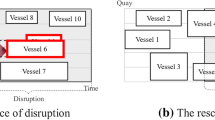Abstract
Container terminals are open systems that generally serve as a transshipment zone between vessels and land vehicles. These terminals carry out a large number of planning and scheduling tasks. In this paper, we consider the problem of scheduling a number of incoming vessels by assigning a berthing position, a berthing time, and a number of Quay Cranes to each vessel. This problem is known as the Berth Allocation Problem and the Quay Crane Assignment Problem. Holds of vessels are also managed in order to obtain a more realistic approach. Our aim is to minimize the total waiting time elapsed to serve all these vessels. In this paper, we deal with the above problems and propose an innovative metaheuristic approach. The results are compared against other allocation methods.
























Similar content being viewed by others
References
Ayvaz D, Topcuoglu H, Gurgen F (2012) Performance evaluation of evolutionary heuristics in dynamic environments. Appl Intell 37(1):130–144
Bierwirth C, Meisel F (2010) A survey of berth allocation and quay crane scheduling problems in container terminals. Eur J Oper Res 202(3):615–627
Cheong C, Tan K, Liu D (2009) Solving the berth allocation problem with service priority via multi-objective optimization. In: IEEE symposium on computational intelligence in scheduling, 2009, CI-sched ’09, pp 95–102
Christiansen M, Fagerholt K, Ronen D (2004) Ship routing and scheduling: status and perspectives. Transp Sci 38(1):1–18
Consultants DS (2010) Global container terminal operators annual review and forecast. Annual Report
Cordeau J, Laporte G, Legato P, Moccia L (2005) Models and tabu search heuristics for the berth-allocation problem. Transp Sci 39(4):526–538
Daganzo C (1989) The crane scheduling problem. Transp Res, Part B, Methodol 23(3):159–175
Feo T, Resende M (1995) Greedy randomized adaptive search procedures. J Glob Optim 6(2):109–133
Festa P, Resende MG (2009) An annotated bibliography of grasp–part ii: applications. Int Trans Oper Res 16(2):131–172
Giallombardo G, Moccia L, Salani M, Vacca I (2010) Modeling and solving the tactical berth allocation problem. Transp Res, Part B, Methodol 44(2):232–245
Guan Y, Cheung R (2004) The berth allocation problem: models and solution methods. OR Spektrum 26(1):75–92
Henesey L (2006) Overview of transshipment operations and simulation. In: MedTrade conference, Malta, April 2006, pp 6–7
Imai A, Nagaiwa K, Tat C (1997) Efficient planning of berth allocation for container terminals in Asia. J Adv Transp 31(1):75–94
Imai A, Chen H, Nishimura E, Papadimitriou S (2008) The simultaneous berth and quay crane allocation problem. Transp Res, Part E, Logist Transp Rev 44(5):900–920
Kim K, Günther H (2006) Container terminals and cargo systems. Springer, Berlin
Kim KH, Park YM (2004) A crane scheduling method for port container terminals. Eur J Oper Res 156(3):752–768
Lai KK, Shih K (1992) A study of container berth allocation. J Adv Transp 26(1):45–60
Lambrechts O, Demeulemeester E, Herroelen W (2008) Proactive and reactive strategies for resource-constrained project scheduling with uncertain resource availabilities. J Sched 11(2):121–136
Lee D, Wang H, Miao L (2008) Quay crane scheduling with non-interference constraints in port container terminals. Transp Res, Part E, Logist Transp Rev 44(1):124–135
Lee DH, Chen JH, Cao JX (2010) The continuous berth allocation problem: a greedy randomized adaptive search solution. Transp Res, Part E, Logist Transp Rev 46(6):1017–1029
Liang C, Huang Y, Yang Y (2009) A quay crane dynamic scheduling problem by hybrid evolutionary algorithm for berth allocation planning. Comput Ind Eng 56(3):1021–1028
Lim A (1998) The berth planning problem. Oper Res Lett 22(2–3):105–110
Liu J, Wan YW, Wang L (2006) Quay crane scheduling at container terminals to minimize the maximum relative tardiness of vessel departures. Nav Res Logist 53(1):60–74
Meisel F, Bierwirth C (2009) Heuristics for the integration of crane productivity in the berth allocation problem. Transp Res, Part E, Logist Transp Rev 45(1):196–209
Mohi-Eldin E, Mohamed E (2010) The impact of the financial crisis on container terminals (a global perspectives on market behavior). In: Proceedings of 26th international conference for seaports & maritime transport
Park Y, Kim K (2003) A scheduling method for berth and quay cranes. OR Spektrum 25(1):1–23
Peterkofsky R, Daganzo C (1990) A branch and bound solution method for the crane scheduling problem. Transp Res, Part B, Methodol 24(3):159–172
Rodríguez-Molins M, Salido MA, Barber F (2010) Domain-dependent planning heuristics for locating containers in maritime terminals. In: Proceedings of the 23rd international conference on industrial engineering and other applications of applied intelligent systems. LNCS, vol 6096. Springer, Berlin, pp 742–751
Rodriguez-Molins M, Salido M, Barber F (2012) Intelligent planning for allocating containers in maritime terminals. Expert Syst Appl 39(1):978–989
Salido M, Sapena O, Barber F (2009) An artificial intelligence planning tool for the container stacking problem. In: Proceedings of the 14th IEEE international conference on emerging technologies and factory automation, pp 532–535
Salido MA, Rodriguez-Molins M, Barber F (2012) A decision support system for managing combinatorial problems in container terminals. Knowl-Based Syst 29:63–74
Stahlbock R, VoßS (2008) Operations research at container terminals: a literature update. OR Spektrum 30(1):1–52
Steenken D, VoßS, Stahlbock R (2004) Container terminal operation and operations research-a classification and literature review. OR Spektrum 26(1):3–49
Szlapczynski R, Szlapczynska J (2012) On evolutionary computing in multi-ship trajectory planning. Appl Intell 37:155–174
Theofanis S, Boile M, Golias M (2009) Container terminal berth planning. Transp Res Rec 2100:22–28
ValenciaPort F (2009) Automation and simulation methodologies for assessing and improving the capacity, performance and service level of port container terminals. Ministerio de Fomento (P19/08), Spain
Vis I, De Koster R (2003) Transshipment of containers at a container terminal: an overview. Eur J Oper Res 147:1–16
Acknowledgements
This work has been partially supported by the research projects TIN2010-20976-C02-01 (Ministerio de Ciencia e Innovación, Spain) the fellowship program FPU (AP2010-4405), and also with the collaboration of the maritime container terminal MSC (Mediterranean Shipping Company S.A.).
Author information
Authors and Affiliations
Corresponding author
Rights and permissions
About this article
Cite this article
Rodriguez-Molins, M., Salido, M.A. & Barber, F. A GRASP-based metaheuristic for the Berth Allocation Problem and the Quay Crane Assignment Problem by managing vessel cargo holds. Appl Intell 40, 273–290 (2014). https://doi.org/10.1007/s10489-013-0462-4
Published:
Issue Date:
DOI: https://doi.org/10.1007/s10489-013-0462-4




